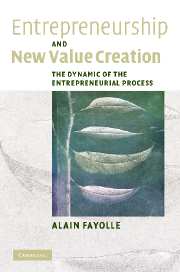Book contents
- Frontmatter
- Contents
- List of figures
- List of tables
- Foreword
- Acknowledgements
- Introduction
- Part I Perceptions of entrepreneurship
- Part II Entrepreneurship and the entrepreneurial system
- Part III Entrepreneurship and entrepreneurial processes
- Part IV Entrepreneurial process dynamics
- 10 Entrepreneurial process trigger phase
- 11 Entrepreneurial process commitment phase
- 12 Entrepreneurial process survival/development phase
- Conclusion
- References
- Index
10 - Entrepreneurial process trigger phase
Published online by Cambridge University Press: 22 September 2009
- Frontmatter
- Contents
- List of figures
- List of tables
- Foreword
- Acknowledgements
- Introduction
- Part I Perceptions of entrepreneurship
- Part II Entrepreneurship and the entrepreneurial system
- Part III Entrepreneurship and entrepreneurial processes
- Part IV Entrepreneurial process dynamics
- 10 Entrepreneurial process trigger phase
- 11 Entrepreneurial process commitment phase
- 12 Entrepreneurial process survival/development phase
- Conclusion
- References
- Index
Summary
The process is triggered by the conjunction of two factors: intention, which is an internal driving force, and displacement, which refers to an external force. These two elements should not be dissociated because they can both contribute to the evolution of the perceived instantaneous strategic configuration. I speak about ‘conjunction’ here, because, in my opinion, both factors are associated in triggering the process. However, these two factors do not always occur in the same order. In some cases, intention appears very early, and it can take a long time before a favourable occasion appears. In other situations, a displacement may trigger the formation of the intention, more or less progressively. I propose, in this chapter, two theoretical frameworks: the concept of displacement introduced by Shapero and the theory of planned behaviour that clarifies the notion of intention and proposes an intention model. I will start with Shapero's work, and then present some of the most famous intention models, before developing the theory of planned behaviour. In the final part of this chapter, I will attempt to combine both theoretical frameworks.
Shapero's entrepreneurial event and factors of displacement
In order to understand better the concept of displacement, I will present and discuss it from the perspective of Shapero and Sokol's model of the entrepreneurial event (1982). Shapero and Sokol's paper (1982) is based on the following question: what kind of social and cultural factors and environments result in entrepreneurial events?
- Type
- Chapter
- Information
- Entrepreneurship and New Value CreationThe Dynamic of the Entrepreneurial Process, pp. 164 - 176Publisher: Cambridge University PressPrint publication year: 2007

